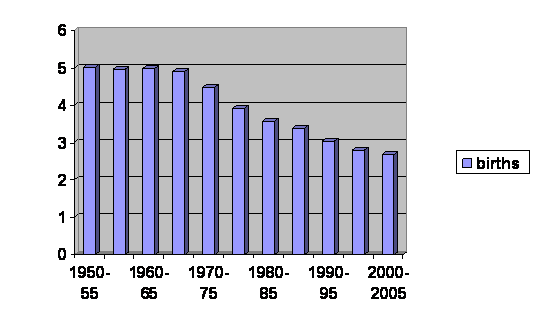
Information from UN statistics: http://esa.un.org/unpp/index.asp?panel=2
World Birth Rate:
Here is a graph of the world’s birth rate over the past five decades. The numbers a births per woman (calculated over her life time, evidently).

Information from UN statistics: http://esa.un.org/unpp/index.asp?panel=2
World Population Prospects: the 2006 Revision Population Database. Variable = Total Fertility. Region = World.
As usual, what we are looking at is data of amazing consistency. Evidently things were stable from the 1950 to 1955 period until the 1970 to 1975 period. Around there we begin the characteristic linear drop. Births drop from about 4.9 per woman in 1965 to 1970 to about 2.68 per woman in the 2000 to 2005 period. That comes out to zero births around 2050 to 2055 and assuming a woman has a thirty year reproductive span, the last cohort of fertile people is born between 2020 and 2055. Any change must be made in the next 12 years. If the point of no return is when birth reach 2 per woman, then we reach that point 13 years after the 2000 to 2005 interval or in 2016 or 8 years from now.
I started working on this in earnest more than 10 years ago. It is quite possible that most of the time then available has already gone by.
It might not be quite so bad. China, during the years covered by the graph, has more than doubled her population. The government has introduced stringent measures go keep the population from exploding. Surely if they were to relax the rules China would rebound? Maybe not. I am not convinced that those rules are all that effective. They may simply be the same baby boom followed by baby bust that has characterized the even more developed world.
The reason for my skepticism is this. China has a one baby rule it the government tries to hold people to. Only one baby is encouraged per couple. And we have been told many times that Chinese prefer boys for children, so the numbers are skewed with fewer girls. Dire warnings have been issued for what happens when all of those boys start looking for wives who are not going to be there. But the numbers are not all that remarkable. There is only an excess of males of about 17% (Phillip Ball, Where have all the flowers gone, NATURE vol. 454, no. 7203 July 24, 2008 page 374).
Something like 10% of men are not going to be interested in marrying normally, so that is only effectively a 7% excess. That is 7% of a very large number, but it hardly seems like the apocalypse.
And if intervention is having a fairly small effect on the sex ratio, then it seems reasonable to guess that intervention is not having much more effect on overall numbers. Furthermore, the far western and far northern provinces, where there is a high proportion of ethnic minorities, tend to have a normal sex ratio. I would expect they have a higher birth rate, too. In other words, trends are following the demographics, not government policy.
So the matter is most urgent. This is not just a matter of rich countries declining and taking our high tech civilization, which is required to feed the numbers already on the planet, down with them. This is a global crisis.
There have been 200 visitors so far.